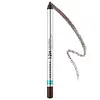What's inside
What's inside
 Key Ingredients
Key Ingredients

 Benefits
Benefits

 Concerns
Concerns

 Ingredients Side-by-side
Ingredients Side-by-side

Isododecane
EmollientTrimethylsiloxysilicate
EmollientCI 77499
Cosmetic ColorantDimethicone
EmollientCI 77491
Cosmetic ColorantSynthetic Wax
AbrasivePolyethylene
AbrasivePolybutene
CI 77492
Cosmetic ColorantCI 77891
Cosmetic ColorantSilica
AbrasivePolyglyceryl-4 Diisostearate/Polyhydroxystearate/Sebacate
EmulsifyingCaprylic/Capric Triglyceride
MaskingStearalkonium Hectorite
Gel FormingAlumina
AbrasiveMagnesium Oxide
AbsorbentPropylene Carbonate
SolventTocopherol
AntioxidantIsododecane, Trimethylsiloxysilicate, CI 77499, Dimethicone, CI 77491, Synthetic Wax, Polyethylene, Polybutene, CI 77492, CI 77891, Silica, Polyglyceryl-4 Diisostearate/Polyhydroxystearate/Sebacate, Caprylic/Capric Triglyceride, Stearalkonium Hectorite, Alumina, Magnesium Oxide, Propylene Carbonate, Tocopherol
Dimethicone
EmollientSynthetic Wax
AbrasiveSilica
AbrasiveStearyl Dimethicone
EmollientCaprylic/Capric Triglyceride
MaskingTrimethylsiloxysilicate/Dimethiconol Crosspolymer
Mica
Cosmetic ColorantOctadecene
SolventDimethicone/Vinyl Dimethicone Crosspolymer
Skin ConditioningPentaerythrityl Tetra-Di-T-Butyl Hydroxyhydrocinnamate
AntioxidantTocopheryl Acetate
AntioxidantPanthenol
Skin ConditioningChamomilla Recutita Flower Extract
MaskingIsoceteth-10
EmulsifyingCI 77891
Cosmetic ColorantCI 42090
Cosmetic ColorantIron Oxides
CI 77492
Cosmetic ColorantCI 77499
Cosmetic ColorantDimethicone, Synthetic Wax, Silica, Stearyl Dimethicone, Caprylic/Capric Triglyceride, Trimethylsiloxysilicate/Dimethiconol Crosspolymer, Mica, Octadecene, Dimethicone/Vinyl Dimethicone Crosspolymer, Pentaerythrityl Tetra-Di-T-Butyl Hydroxyhydrocinnamate, Tocopheryl Acetate, Panthenol, Chamomilla Recutita Flower Extract, Isoceteth-10, CI 77891, CI 42090, Iron Oxides, CI 77492, CI 77499
 Reviews
Reviews

Ingredients Explained
These ingredients are found in both products.
Ingredients higher up in an ingredient list are typically present in a larger amount.
This ingredient is an emollient, solvent, and texture enhancer. It is considered a skin-softener by helping the skin prevent moisture loss.
It helps thicken a product's formula and makes it easier to spread by dissolving clumping compounds.
Caprylic Triglyceride is made by combining glycerin with coconut oil, forming a clear liquid.
While there is an assumption Caprylic Triglyceride can clog pores due to it being derived from coconut oil, there is no research supporting this.
Learn more about Caprylic/Capric TriglycerideCi 77492 is also hydrated iron III oxide. It's sole purpose is to give a yellow hue to products.
Iron III oxides are classified as inorganic chemicals for coloring.
Synthetically created Ci 77492 is considered safer than those naturally found. This is because the synthetically created version may contain less impurities. Iron oxides are generally non-toxic and non-allergenic.
Learn more about CI 77492Ci 77499 is also hydrated iron III oxide. It is created from mixing red and black iron oxides. This helps give shades of darkness to a product.
Iron III oxides are classified as inorganic chemicals for coloring.
Ci 77891 is a white pigment from Titanium dioxide. It is naturally found in minerals such as rutile and ilmenite.
It's main function is to add a white color to cosmetics. It can also be mixed with other colors to create different shades.
Ci 77891 is commonly found in sunscreens due to its ability to block UV rays.
Learn more about CI 77891Dimethicone is a type of synthetic silicone created from natural materials such as quartz.
What it does:
Dimethicone comes in different viscosities:
Depending on the viscosity, dimethicone has different properties.
Ingredients lists don't always show which type is used, so we recommend reaching out to the brand if you have questions about the viscosity.
This ingredient is unlikely to cause irritation because it does not get absorbed into skin. However, people with silicone allergies should be careful about using this ingredient.
Note: Dimethicone may contribute to pilling. This is because it is not oil or water soluble, so pilling may occur when layered with products. When mixed with heavy oils in a formula, the outcome is also quite greasy.
Learn more about DimethiconeSilica, also known as silicon dioxide, is a naturally occurring mineral. It is used as a fine, spherical, and porous powder in cosmetics.
Though it has exfoliant properties, the function of silica varies depending on the product.
The unique structure of silica enhances the spreadability and adds smoothness, making it a great texture enhancer.
It is also used as an active carrier, emulsifier, and mattifier due to its ability to absorb excess oil.
In some products, tiny microneedles called spicules are made from silica or hydrolyzed sponge. When you rub them in, they lightly polish away dead skin layers and enhance the penetration of active ingredients.
Learn more about SilicaSynthetic Wax is created from fossil fuels such as natural gas. It is used to enhance texture, adjust pH, and as an occlusive.
It may also be used as an abrasive ingredient to exfoliate the skin.
Synthetic Wax may not be fungal acne safe.
Learn more about Synthetic Wax